SUMMARY
This is AI generated summarization, which may have errors. For context, always refer to the full article.
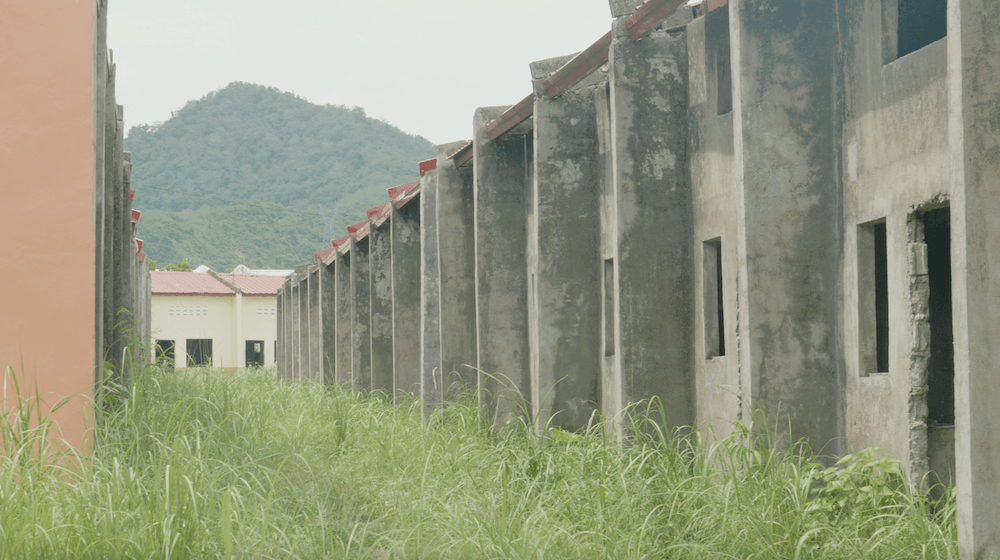
This story is part of Rappler’s series on the 10th anniversary of Super Typhoon Yolanda (Haiyan).
Yolanda was one of the most powerful typhoons in history to make landfall on November 8, 2013. The super typhoon claimed thousands of lives and displaced millions from their homes. Ten years later, Rappler visits some of the affected communities to see what life has been like since the disaster.
TACLOBAN, Philippines – A young tree grows under metal beams of what should have been a roof, beside a door frame that should have led to a bathroom.
Outside, by the not-front door, a clump of grass taller than a man greets guests, bending forward in a gesture of welcome. Outside, what should have been a path between houses is a garden so thick that a human would need to cut through it to get across.
Everywhere one looks, gray, unpainted houses with dark chasms for windows and doors are smothered by vegetation.
The only other sign of life are heavy brown piles by the doorways, turds of carabaos that come here to graze.
This is life in Carigara Housing Project 1, one of the oldest and still unfinished housing sites intended for survivors of Super Typhoon Yolanda (Haiyan).
It was started in 2015, after the late president Benigno Aquino III created the funding source for all Yolanda housing projects, some P76 billion for resettlement efforts. Tarpaulins at the entrance had proclaimed it would be completed by 2017. Six years later, the housing site is nearly overrun by weeds.
It cost P197 million ($3.46 million) in taxpayers’ money – the equivalent of 75 classrooms, or the one-year salary of 606 public school teachers with salary grade 11.
Carigara Housing Project 1 is not the only unfinished Yolanda housing project. Though it’s been 10 years since the storm, one of the world’s most devastating, around 15% of target housing sites intended for survivors remain incomplete, according to a September 2023 National Housing Authority (NHA) report sent to Rappler.
The NHA says 172,454 houses have been completed as of September 2023. This means 31,020 houses are still incomplete a decade after Yolanda.
This appears to be an improvement from a year ago, when the Commission on Audit reported that 20% of the target then was incomplete. However, the NHA also lowered their number of target housing units this year. From 210,317 target units a year ago, they declared a new target of 203,474 housing units for 2023.

The lower target would then increase the completion rate. This is not the first time the government has changed its target number of houses. COA reports said these decreases in targets were typically due to the higher cost of construction materials, budget constraints for projects under terminated contracts, unsettled boundary disputes affecting project sites, and more.
If we use the same target from 2022 against the number of completed houses as of September this year, the percentage of uncompleted houses would be at 18%, a slight improvement. It would mean 37,863 target houses are yet to be finished.
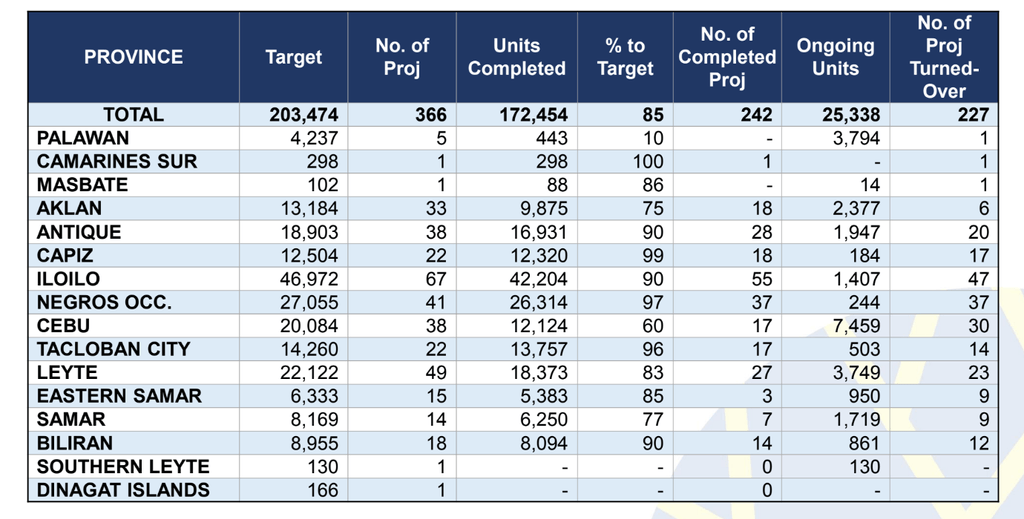
Every delay means a waste of taxpayers’ money.
In the COA’s 2022 assessment of the Yolanda Permanent Housing Project, 60 housing projects worth P9.3 billion ($163.27 million) were all together not completed on time. Meanwhile, 56 projects worth P8.7 billion ($152.71 million) had to be terminated.
The reasons for termination range from failure to convert the land from timberlands to housing, to prolonged inability of contractors to meet deadlines and targets of the contract.
While over 170,000 houses have been built across the country, a big chunk of them are not even occupied. While the latest figures from NHA don’t show the rate of occupancy, COA documents from a year ago indicated that 30% of built Yolanda houses are not even being used by their intended beneficiaries.
At the time, that was equivalent to 51,538 houses.
Survivors left behind
Godofredo Labareno, 60, survived Yolanda and managed to get odd jobs related to the construction of the Carigara Housing Project, built on land he had previously occupied.
It was his hands that set up the houses' steel frames, built the culverts for water to flow through. For three years, he and two other men have served as watchmen to the empty housing site.

But funds from the contractor, Hi-Tri Development Corporation (Hi-Tri), a Marcos-linked company which won the NHA bid for the project, appeared to dry up. Less and less work was being done on the site. Eventually, Labareno would rue the day he agreed to cooperate with the housing effort.
In October, Labareno said Hi-Tri has not paid him his salary for almost two years, since March 2021. He is buried in debt after borrowing money for his wife's hospitalization.
"Wala na talaga itong pag-asa. Hindi na siguro matatapos ito. Sayang 'yung tulong ko sa kanila," he told Rappler. (This is hopeless. This probably won't get finished anymore. All the help I extended was wasted.)
He called on President Ferdinand Marcos Jr. to complete the housing site. What he is most disappointed with, however, is how the economy has fared under Marcos, causing more hardship to Yolanda survivors."Lahat siguro ng tao sa Leyte, bumoto kay Marcos. Nabudol siguro kami. Nabudol talaga!" he said. (Probably everyone in Leyte voted for Marcos. Maybe we were fooled. We were really fooled!)
Hi-Tri's link to the Marcoses
Registered with the Securities and Exchange Commission since 1974, Hi-Tri is owned by the Bakunawa family which has ties to the Marcoses.
It recorded total assets of P419 million at the time it won a bid for the Carigara housing contract. According to its December 2014 balance sheet, its total liabilities then stood at P17 million with a net income after tax of P10.8 million.
Based in Quezon City, the firm had contracts with the Department of Public Works and Highways, mostly for projects in Mindanao.
The Presidential Commission on Good Government (PCGG) had accused the Bakunawas of illegally profiting from close ties with the Marcoses during the dictatorship. The PCGG went so far as to accuse Luz Reyes-Bakunawa and husband Manuel Bakunawa Jr., who owned Hi-Tri back then, of being dummies of former president Ferdinand E. Marcos and then-first lady Imelda Marcos, according to a 2013 Supreme Court document.
Luz Reyes-Bakunawa, by her lawyers’ own admission, worked as staff under Imelda Marcos’ Social Secretary. She would eventually be elected to public office as Masbate 2nd District Representative.
Hi-Tri itself was among the Bakunawa’s assets that were identified for forfeiture to the government, along with six other companies.
The PCGG, tasked to run after the Marcos’ ill-gotten wealth, pointed to the awarding of negotiated contracts for public works projects to Bakunawa companies as evidence of collusion with the first family then.
The Sandiganbayan, however, decided against the PCGG in a 2002 resolution. After an appeal by the PCGG, the Sandiganbayan again decided in favor of the Bakunawas in 2007, in a resolution penned by then-associate justice Diosdado Peralta. In 2013, the Supreme Court also weighed in, affirming the Sandiganbayan’s ruling.
The High Court, in a decision written by then-associate justice and now Executive Secretary Lucas Bersamin, said the PCGG “did not preponderantly establish the ill-gotten nature of the Bakunawas’ wealth.” Then-chief justice Maria Lourdes Sereno concurred with the decision.
The Bakunawas had insisted their wealth was acquired honestly and that their businesses wholly belonged to the family, and not the Marcoses.

Manuel Bakunawa III, son of Luz and Manuel Jr., is the current board chairman of Hi-Tri, according to the firm’s General Information Sheet.
In 2018, NHA Eastern Visayas said it had not yet paid Hi-Tri for two Carigara housing projects – one costing P129 million, and the other, P197 million. The contracts for these projects were signed in October 2014 and April 2015, respectively.
Fast forward to 2022, Hi-Tri’s total assets grew to P711 million but its liabilities also grew to P116 million. By this time, it had taken on significantly more debt, P113 million in big loans payable. Its net income tax that year was P3.6 million.
Hi-Tri has not responded to Rappler’s request for comment about why they were unable to finish the Carigara housing project on time. We will update this story when they respond.
The COA, in its 2022 report, said non-occupancy of Yolanda houses poses a "significant risk" to the government program because such houses are likely to deteriorate faster.
"Unoccupied [housing units] are more susceptible to natural wear and tear, weather damage, vandalism, and exposure to risk of invasion by illegal occupants and other unauthorized persons, contrary to Section 2 of PD No. 1445," said the audit agency.
It warned that such prolonged failure to complete the houses may have forced Yolanda victims to live in temporary shelters or stay with relatives, "which can be uncomfortable or unsafe, or pay for rent while waiting for their socialized housing units to be completed and awarded, putting them under additional financial strain and exacerbating the trauma they have experienced, thus, defeating the purpose of the project."
Housing had been identified as a priority rehabilitation effort to help survivors who lost their homes to winds, floods, and landslides, and to encourage those still living in "danger zones" to move out permanently. While Yolanda houses languish, government spending on climate resilience and disaster preparedness has been slow. A new study by Oxfam Pilipinas showed how, from 2016 to 2020, the local and national governments failed to spend 26% of disaster funds.
Three presidents – Aquino, Rodrigo Duterte, and incumbent President Marcos – have so far failed to put a capstone on the large-scale government housing effort.
They have also failed to address numerous problems faced by people who live in the Yolanda housing sites, chief among them the lack of utilities like a water connection and distance from jobs and livelihoods. (To be concluded) – Rappler.com
NEXT: Part 2 | Water, electricity issues bog Yolanda relocation plans
$1 = P56.96
ALSO ON RAPPLER
- After Yolanda: A causeway threatens efforts by locals to restore a mangrove forest
- PANOORIN: Mga Kuwentong Yolanda
- Rappler Talk: Alfred Romualdez on learnings from Yolanda, 10 years later
- Call her Landa
- After Yolanda: A teacher’s dream for the children of Guiuan
- Rappler Talk: Guiuan’s decade of recovery after Yolanda
- WATCH: How the people of Eastern Samar take care of the environment
- Rappler Recap: ‘Work is not done,’ Marcos says of Yolanda recovery
- Rappler Recap: Tacloban residents light candles for 10th year of Yolanda
- On Yolanda’s 10th year, groups urge gov’t to ‘hold big polluters accountable’
- Marcos resurrects issue of ‘uncounted, unrecorded’ victims of Yolanda
- [Under 3 Minutes] Kumusta na ang Yolanda housing projects?
Add a comment
How does this make you feel?









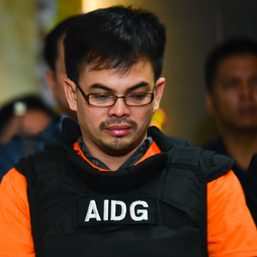


![[WATCH] In the Public Square with John Nery: Abolish the National Housing Authority?](https://www.rappler.com/tachyon/2024/03/In-the-Public-Square-LS.jpg?resize=257%2C257&crop=377px%2C0px%2C1080px%2C1080px)
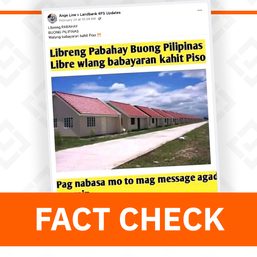
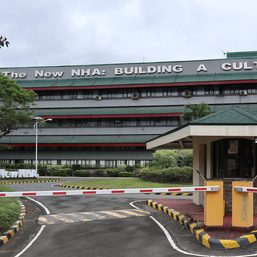
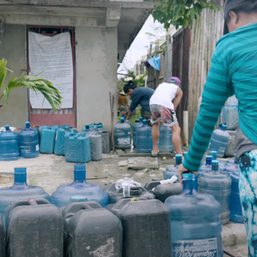
![[Under 3 Minutes] Kumusta na ang Yolanda housing projects?](https://www.rappler.com/tachyon/2023/11/title-card-ls-3.jpg?resize=257%2C257&crop_strategy=attention)

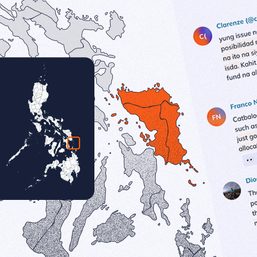


There are no comments yet. Add your comment to start the conversation.